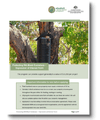Your Black-Cockatoo Sighting Could Save a Species
Have you spotted our endangered Carnaby’s Black-Cockatoos around the Wheatbelt lately? It’s prime nesting season, and we are keen to hear about your observations!
At this time of year, Carnaby’s are nesting in tree hollows that are at least 100 years old, as only hollows of this age provide the space they need. They must also be located within 2km of fresh water and 6-12km of reliable food sources to sustain both the adults and chicks throughout the breeding season.
As you can imagine, these nesting sites are highly prized and difficult to come by. Combined with other pressures such as nest competition, habitat loss, predation, shooting, and vehicle impact, it is no wonder this species is in dire need of assistance.
If you are interested in playing a part in protecting the habitat vitally needed for the survival of the Carnaby’s, applications are now open for our “Protecting WA Black-Cockatoos” project.
If you have 10ha of bushland on your property that is used by Carnaby’s for feeding, nesting or roosting you could be eligible for support. Fill out an application below or contact Project Manager Kate Sherlock.
Application Form (Fillable)
Download
Interesting Facts:
The timing of egg laying is influenced by the onset and volume of autumn rainfall. With this year’s rainfall being average for the region, it is likely that many Carnaby’s pairs have already selected hollows and begun incubation.
The female will stay in the nest for the next 28-29 days and be solely reliant on her mate to supply her with sustenance.
Each season, Carnaby’s typically lay one or two eggs. Usually only one chick survives to fledgling stage, but if food is abundant and the parents can support both, it is possible for two chicks to fledge.
Hollow entries can be surprisingly cryptic. They can open from the top (as in artificial hollows), from the side of the trunk, or from the end of a branch (known as a spout).
Keen to dust off your binoculars? Community observations play a vital role in helping us identify new nest sites and deepen our understanding of their breeding habits.
Here’s what to look for:
A single bird in a tree – this is likely to be a mate sitting near a hollow while the other is inside. Later in the season, as the chick grows and space becomes limited, you may see both adults outside the hollow.
A male feeding a female is a clear sign of nesting activity and likely indicates the presence of eggs or chicks less than 3 weeks old.
A small group of males and juveniles foraging or drinking. This indicates that there are nesting females within 12 kms.
Fresh chipping or nibbling around the entrance of a hollow. Carnaby’s make a bed of woodchips in their hollow when nesting is underway.
From mid-late November chicks will begin to fledge. You may see adults and a juvenile sitting and foraging together.
Important: Don’t approach or disturb a tree that you suspect contains a nesting hollow.
Report a Sighting
Don’t keep your discoveries to yourself, we want to hear all about it! Click on the survey button below to let us know what you’ve seen. And remember to check out our project to see if you’re eligible to partner with us to improve the outlook for our beautiful Carnaby’s Black-Cockatoo.
These projects are funded by the Australian Government Natural Heritage Trust and delivered by Wheatbelt Natural Resource Management, a member of the Regional Delivery Partners panel.
Published eNews #407 – October 2025


